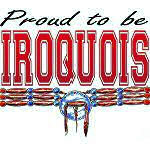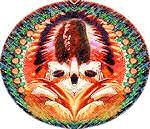AUTHOR: Excerpt from The Indian Tribes of North America, by John R. Swanton
Indiana’s most influential Indian tribes were the Miami, Wea, and Piankashaw. Yet, there were other tribes that also left their mark in and on the state.
Chippewa Tribe
 Buy this Chippewa design on clothing and gifts. Buy this Chippewa design on clothing and gifts. |
The Chippewa or Ojibwe were a tribe of the east coast and the Great Lakes area. Like the Miamis, they were part of the Algonquin linguistic group. In treaties made in 1795, 1817, and 1821, they relinquished their lands in Indiana to the whites. Their tribal name means “to roast until puckered,” and referred to the puckered seam in their moccasins.
Delaware Indians
The Delaware Indians were also of Algonquin stock. They originated on the east coast (Delaware River) and later moved westward into Ohio. In 1770, they obtained permission from the Miami and Piankashaw to move into the area between the Ohio and White Rivers in Indiana. They established six villages in this area, but later moved west to Missouri, Kansas, and Oklahoma.
Illinois Indians
The Illinois Indians were most prominent in Illinois but also had lands in Indiana which they relinquished in 1795 to the whites. Although most closely related to the Miamis, they were often at odds with them. Their tribal name means “men” or “people.”
 |
| Buy this Iroquois design on clothing and gifts |
Iroquois and Seneca tribes
The Iroquois and Seneca tribes, originally from the New York area, were responsiblefor driving out the early native residents of Indiana, but they had few, if any, settlements in Indiana themselves.
The Kickapoo tribe
 |
| Buy this Kickapoo design on clothing and gifts |
The Kickapoo tribe lived primarily in Wisconsin and on the Vermilion River in Illinois, but also occupied areas in western Indiana, especially on the Wabash River. Their name means “he moves about, standing now there, now there.” They were of the Algonquin linguistic group.
Mosopeliea tribe – the dog people
The Mosopelea was a tribe that spoke the Sioux dialect. In 1673 they were living in southwestern Ohio and most likely extended into southeastern Indiana. They later went west, to the juncture of the Mississippi and Ohio Rivers, then southward through Kentucky, Tennessee, Arkansas, and Mississippi. They were also known as Ofo, or “dog people.”
Potawatomi Indians
The Potawatomi, meaning “people of the place of the fire,” occupied lands in Michigan, but extended their settlements into northern Indiana in the 1700s until they gave up their lands to the United States in the 1800s.
They were of the Algonquin linguistic group.
 Buy this Shawnee Prophet design on posters, patches, clothing and gifts. Buy this Shawnee Prophet design on posters, patches, clothing and gifts. |
Shawnee Indians of Indiana
The Shawnee, although primarily a southern tribe of Kentucky and Tennessee, were always on the move and played a role in Indiana history. They had an ancient town at the joining of the Ohio and the Wabash rivers, in Posey County. They were of the Algonquin linguistic group and related to the Kickapoo.
Their chief, Tecumseh, and his brother, The Prophet (Tenskwatawa), both sought to create Indian uprisings against the whites, advocating a return to their ancestral way of life, free from white influence. The Prophet fought at the Battle of Tippecanoe, north of Lafayette, in 1811, and was defeated by General William Henry Harrison. The Shawnee name means “southerners.”
The Wyandot tribe were also known as the Hurons
The Wyandot tribe of Wisconsin and Ohio ceded their Indiana lands to the whites in 1795. Their tribal name means “dwellers on a peninsula.” They were of the Iroquoian linguistic group. They were also called Hurons, meaning “rough,” by the French.